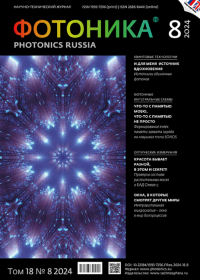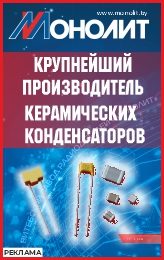Conferences, exhibition & seminars
A. V. Naumov
Photonics: Refinement Technique DOI: 10.22184/1993-7296.FRos.2024.18.8.592.597
Photonics: Refinement Technique DOI: 10.22184/1993-7296.FRos.2024.18.8.592.597
Photonic Integrated Circuits
A. E. Gabdrakhmanov, E. N. Rybachek, E. M. Yeganova, D. V. Ryazantsev, N. V. Komarova, A. E. Kuznetsov
Development of Charge Trapping SONOS Memory Cells DOI: 10.22184/1993-7296.FRos.2024.18.8.598.607
In this paper, a process for creating a SONOS memory cell with an improved structure within
the CMOS route according to 1.5 μm process standards that can be integrated to silicon
photonics is proposed. The resulting memory has a write voltage of 12 V and an erase voltage
of –13 V. The write speed is 80 ms. The memory window is more than 3 V with a working
window of 2 V.
Development of Charge Trapping SONOS Memory Cells DOI: 10.22184/1993-7296.FRos.2024.18.8.598.607
In this paper, a process for creating a SONOS memory cell with an improved structure within
the CMOS route according to 1.5 μm process standards that can be integrated to silicon
photonics is proposed. The resulting memory has a write voltage of 12 V and an erase voltage
of –13 V. The write speed is 80 ms. The memory window is more than 3 V with a working
window of 2 V.
Optical Devices & Systems
A. N. Melnikov
Controlling Mirror Mutual Arrangement in Three-Mirror Telescopes Using Computer-Generated Hologram Optical Elements DOI: 10.22184/1993-7296.FRos.2024.18.8.630.638
A solution to the precision control issue of mirror mutual arrangement in centered three-mirror telescopes is proposed based on the application of axial computer-generated hologram optical elements (CGHOE) both at the stage of telescope assembly and adjustment and during operation to ensure their regular additional adjustment.
Controlling Mirror Mutual Arrangement in Three-Mirror Telescopes Using Computer-Generated Hologram Optical Elements DOI: 10.22184/1993-7296.FRos.2024.18.8.630.638
A solution to the precision control issue of mirror mutual arrangement in centered three-mirror telescopes is proposed based on the application of axial computer-generated hologram optical elements (CGHOE) both at the stage of telescope assembly and adjustment and during operation to ensure their regular additional adjustment.
Tags: adjustment assembly centered three-mirror telescope circular axial computer-generated hologram optical element cylindrical axial computer-generated hologram optical element laser-holographic control of mirror mutual arrangement radial-sector axial computer-generated hologram optical elemen regular additional adjustment круговой осевой синтезированный голограммный оптический элемент лазерно-голографический контроль взаиморасположения зеркал радиально-секторный осевой синтезированный голограммный оптичес регулярная подъюстировка сборка центрированный трехзеркальный телескоп цилиндрический осевой синтезированный голограммный оптический эл юстировка
M. A. Zavyalova, P. S. Zavyalov, A. V. Soldatenko
Confocal Hyperchromatic Optical System with the Enhanced Energy Characteristics DOI: 10.22184/1993-7296.FRos.2024.18.8.622.628
A new concept of a confocal sensor designed to measure the displacements and surface
microprofiles of the optical transparent media is proposed. The sensor is based on a superluminescent diode and a hyperchromatic lens. The sensor uses a multimode fiber-optic
coupler and a radiation source with a spectral width of 40 nm. The displacement and elevation
difference of the object are determined by measuring the spectrum of radiation reflected from the surface, with isolation of the dominant wavelength using the special software algorithms and implementation of the confocality principle of the sensor’s optical scheme.
Confocal Hyperchromatic Optical System with the Enhanced Energy Characteristics DOI: 10.22184/1993-7296.FRos.2024.18.8.622.628
A new concept of a confocal sensor designed to measure the displacements and surface
microprofiles of the optical transparent media is proposed. The sensor is based on a superluminescent diode and a hyperchromatic lens. The sensor uses a multimode fiber-optic
coupler and a radiation source with a spectral width of 40 nm. The displacement and elevation
difference of the object are determined by measuring the spectrum of radiation reflected from the surface, with isolation of the dominant wavelength using the special software algorithms and implementation of the confocality principle of the sensor’s optical scheme.
Tags: chromatic encoding method confocal method hyperchromatic systems non-contact optical measurements бесконтактные оптические измерения гиперхроматические системы конфокальный метод метод хроматического кодирования
Quantum Technologies
V. G. Krishtop
Single-Photon Sources. Review. Part 2 DOI: 10.22184/1993-7296.FRos.2024.18.8.610.620
This review discusses various ways to create single-photon sources (SPS). The task of
generating single photons can be solved in various ways, and at the moment there is no one among them that would be significantly preferable. The first part of the review discussed the
requirements for single-photon sources and criteria for characterizing sources. The first part
of the review included single photons sources based on single ions and based on single atoms.
The second part reviews SPS based on quantum dots and color centers in crystals.
Single-Photon Sources. Review. Part 2 DOI: 10.22184/1993-7296.FRos.2024.18.8.610.620
This review discusses various ways to create single-photon sources (SPS). The task of
generating single photons can be solved in various ways, and at the moment there is no one among them that would be significantly preferable. The first part of the review discussed the
requirements for single-photon sources and criteria for characterizing sources. The first part
of the review included single photons sources based on single ions and based on single atoms.
The second part reviews SPS based on quantum dots and color centers in crystals.
Optical Measurements
S. М. Kuznetsov, V. S. Novikov, D. D. Vasimov, P. K. Laptinskaya, V. V. Kuzmin, M. N. Moskovskiy, E. A. Sagitova
Raman Spectroscopy of Vegetable Oils and Omega 3 Fish Oil Supplements: Quantitative Analysis DOI: 10.22184/1993-7296.FRos.2024.18.8.650.659
This paper discusses the potential of Raman spectroscopy for the characterization of
vegetable oils and dietary supplements based on polyunsaturated fatty acids of the
omega‑3 family (ω‑3 PUFA). The present study demonstrates that Raman spectra can be
employed to determine the iodine value of vegetable oils, form of ω‑3 PUFA, relative total
ω‑3 PUFA content, and ratio of the mass fractions of eicosapentaenoic (EPA) and docosahexaenoic (DHA) acids in the Оmega‑3 dietary supplements.
Furthermore, the paper discusses potential applications of the principal component analysis
(PCA) to Omega‑3 supplement characterization using Raman spectra.
Raman Spectroscopy of Vegetable Oils and Omega 3 Fish Oil Supplements: Quantitative Analysis DOI: 10.22184/1993-7296.FRos.2024.18.8.650.659
This paper discusses the potential of Raman spectroscopy for the characterization of
vegetable oils and dietary supplements based on polyunsaturated fatty acids of the
omega‑3 family (ω‑3 PUFA). The present study demonstrates that Raman spectra can be
employed to determine the iodine value of vegetable oils, form of ω‑3 PUFA, relative total
ω‑3 PUFA content, and ratio of the mass fractions of eicosapentaenoic (EPA) and docosahexaenoic (DHA) acids in the Оmega‑3 dietary supplements.
Furthermore, the paper discusses potential applications of the principal component analysis
(PCA) to Omega‑3 supplement characterization using Raman spectra.
Tags: dietary supplements iodine value omega‑3 fatty acids principal component analysis raman spectroscopy vegetable oils биологически активные добавки йодное число метод главных компонент омега‑3 кислоты растительные масла спектроскопия комбинационного рассеяния света
Biophotonics
M. A. Keldysh, O. N. Chervyakova, O. V. Shelepova, I. V. Mitrofanova, I. V. Petrunya, K. A. Sudarikov, A. A. Gulevich, E. N. Baranova
Comparative Analysis of Optical Methods for Detection and Identification of Viral Infection During Monitoring of Vegetati DOI: 10.22184/1993-7296.FRos.2024.18.8.660.669
The article discusses the issues of assessing the prospects for detecting latent viral infection for monitoring viral pathogens using digital processing of images obtained by an optical digital camera and hyperspectral images. Information on 13 types of viruses that have been registered in some regions where Syringa L. grows is provided. Data on the species composition of Syringa viruses in the ecosystems of the Main Botanical Garden and the Moscow region and their symptoms are described. Based on the virological examination, specialized pathogens Lilac ring mottle ilarvirus (LRMV), Lilac leaf chlorosis ilarvirus (LLCV), as well as Carnation mottle carmovirus, Cucumber mosaic cucumovirus, Alfalfa mosaic alfamovirus and Potato Y potyvirus, which are not typical for lilacs, were diagnosed on lilac. As a result of system monitoring, the frequency of occurrence of seven viruses was determined.
Comparative Analysis of Optical Methods for Detection and Identification of Viral Infection During Monitoring of Vegetati DOI: 10.22184/1993-7296.FRos.2024.18.8.660.669
The article discusses the issues of assessing the prospects for detecting latent viral infection for monitoring viral pathogens using digital processing of images obtained by an optical digital camera and hyperspectral images. Information on 13 types of viruses that have been registered in some regions where Syringa L. grows is provided. Data on the species composition of Syringa viruses in the ecosystems of the Main Botanical Garden and the Moscow region and their symptoms are described. Based on the virological examination, specialized pathogens Lilac ring mottle ilarvirus (LRMV), Lilac leaf chlorosis ilarvirus (LLCV), as well as Carnation mottle carmovirus, Cucumber mosaic cucumovirus, Alfalfa mosaic alfamovirus and Potato Y potyvirus, which are not typical for lilacs, were diagnosed on lilac. As a result of system monitoring, the frequency of occurrence of seven viruses was determined.
Tags: adaptivity monitoring ndvi phytoviruses pri rgb syringa l. адаптивность видовой состав мониторинг фитовирусы
Optical measurements
М. Е. Stepanov, А. А. Vlasov, P. А. Demina, R. А. Akasov, G. Babaeva, V. I. Yusupov, Т. V. Egorova, К. R. Karimullin, А. N. Generalova, А. V. Naumov, Е. V. Khaydukov
Intravital Microscopy – a Window Into the World of Bioprocesses DOI: 10.22184/1993-7296.FRos.2024.18.8.640.648
The article shows the potential of practical use of the dorsal skin fold optical microscopy
method as an effective diagnostic technology for biosystems. It has been experimentally
proved that even in the basic formulation, the presented method allows obtaining a large
amount of useful research data in conditions as close as possible to native ones.
Intravital Microscopy – a Window Into the World of Bioprocesses DOI: 10.22184/1993-7296.FRos.2024.18.8.640.648
The article shows the potential of practical use of the dorsal skin fold optical microscopy
method as an effective diagnostic technology for biosystems. It has been experimentally
proved that even in the basic formulation, the presented method allows obtaining a large
amount of useful research data in conditions as close as possible to native ones.
Tags: dark-field fluorescence microscopy life sciences light-field microscopy in white light optical clearing agents науки о жизни оптические просветляющие агенты светлопольная микроскопия в белом свете темнопольная флуоресцентная микроскопия
Annual Issue

 rus
rus


